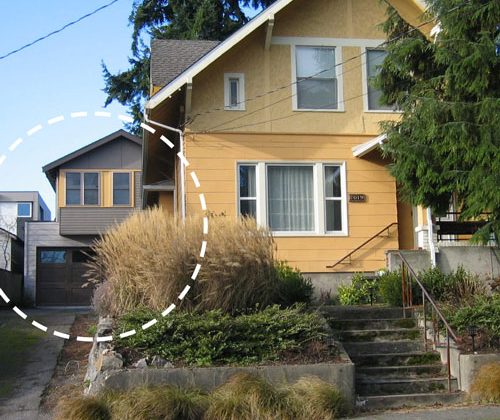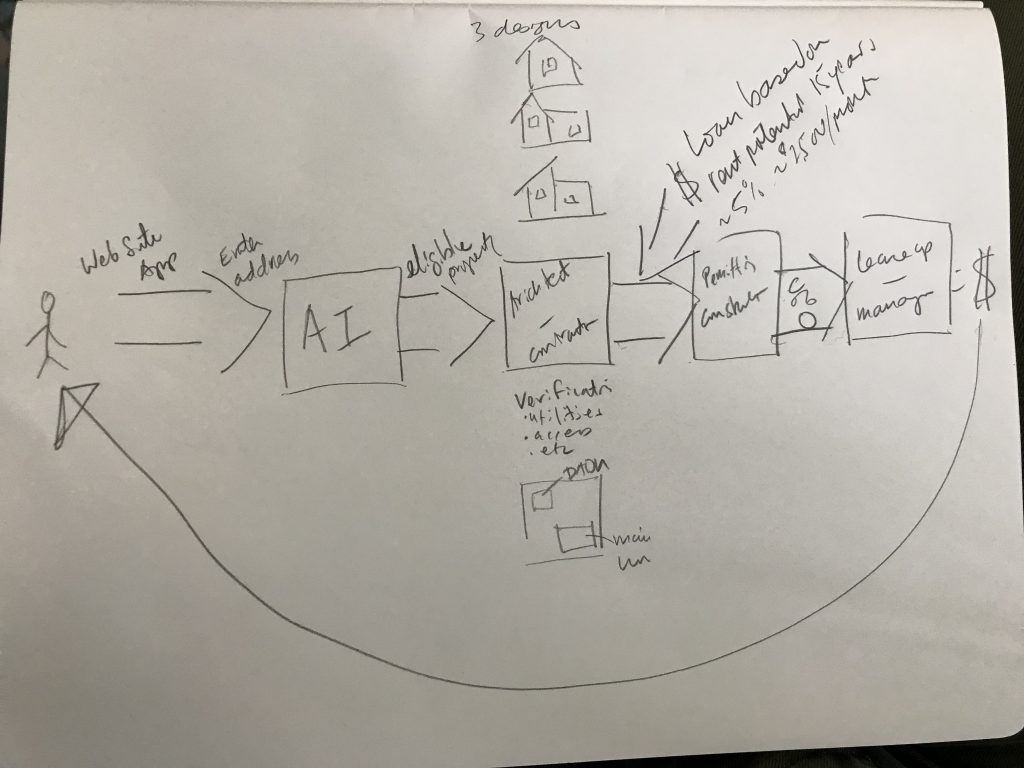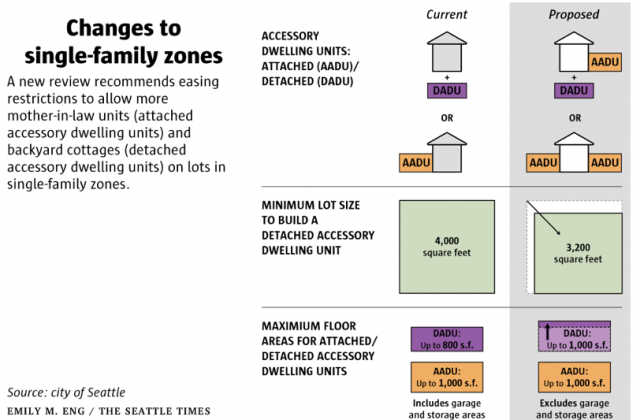DADUTÉ: The Detached Accessory Dwelling Unit Tax Exemption Program
Yesterday, I wrote about a way to capture the value in thousands of backyards by creating a loan product that could spark a market in building and producing Detached Accessory Dwelling Units (DADUs) or backyard cottages as they are often called. Today, for those who think that $2500 is too expensive and want lower rents, we have another great idea: the Detached Accessory Dwelling Unit Tax Exemption (DADUTÉ) Program. I added an accent at the end.
The City of Seattle has a program that is allowed by state law called the Multifamily Tax Exemption (MFTE) Program. This program allows landlords and tenants of new apartment buildings to share a tax exemption when developers set aside 20 percent of the units in a building for people who earn below 60 percent of Area Median Income (AMI), that’s about $42,000 per year or about $3,500 a month.
As I pointed out yesterday, I’m guessing that rents for a DADU in Seattle would reasonably run about $2500 a month to cover the construction and financing of the cottage. That could be more or less depending on the costs. If the idea of financing these produces enough money, a market will grow, competition will increase, and prices for everything would drop, including the rents. But today, 100 percent of AMI is about $72,000 for a two person household, that’s about $1,800 for rent based on the normative standard of 30 percent of gross monthly income spent for housing.
Through a tax exemption program, property taxes could be significantly reduced; that would mean better financing options (lower interest rates) and savings for the homeowner that would match up or exceed the $700 between the rents that might be required, just like the MFTE program does for rental properties. Yes, this would be subsidy for people with a household income of more than $70,000, but these would be households that could leave rental housing where that household would be paying less. That unit vacated by that household would then be available for another household.
I have no idea what the math would be across the city, but the point is that prices will come down with competition between lenders and builders, and, if the City came along with a DADUTÉ Program set up like MFTE, it’s likely even more people would want to get some benefits from reduced taxes and rent revenue. And people looking for housing would have a whole new rental product available. More overall housing supply would stabilize prices along with the potential rent reductions from the DADUTÉ Program.
When we asked people from Oregon why there are more DADUs there, they said that it was because local government reduced or eliminated system charges for utility connections. This acted as an incentive. So along with a market solution, a subsidy through a tax exemption program could set fire to the DADU market and transform housing production in the city. It’s an idea. We need to do more quantitative analysis but it’s worth doing regardless of the recent tweaks to the code.
How a Philosophy Major Made Millions on Backyard Cottages
Everyone is annoyed with Ol’ Marty Kaplan for appealing legislation that tweaks the City’s existing rules on building backyard cottages. You’d think that the legislation was going to legalize backyard cottages. But here’s the deal: they are already legal, and have been for almost a decade. The code certainly can and should be improved to make it more permissive. Anyone with a backyard should be able to create rental housing on their own property. But even if we got there, and there were very few rules, there’s no way to finance backyard cottages as I pointed out last week. So here’s my million dollar idea to make that happen.
A set of investors could capitalize a fund of $50 million that would support a DADU service and product. I liked the name Cottage Ease.
Cottage Ease would have an app and a web page that would allow a homeowner to put in their address. An AI would give a red, yellow, or green indicator based on the code and the parcel.
If yellow or green, someone from the company would verify that a cottage would work, make sure there aren’t any deal killing site defects, then alert the design build team.
The owner could choose from three stock options for cottages. These would be pre-approved or screened by the City for quicker permitting. A contractor would fold the order into its work load, and the company would supervise construction.
The fund would create a loan with the house and property as collateral — a lien on the title for the life of the loan — and base the loan on, say, $2500 per month rent which would cover a 5% loan over 15 years of debt service.
That would cover about $250,000 complete cost for the cottage plus costs of putting the whole project together and also leasing up the unit. This way, a homeowner would just point and click and within a year have cash flowing from a rental unit in their back yard.
If cottages averaged about $250,000 per unit, the fund would be able to produce about 100 units over a 18 month period for about $25,000,000. My bet would be that once those loans started to produce some value, banks would start getting interested, first as lenders to the fund but eventually as the originators. At the national level, Congress might be persuaded to allow the Federal National Mortgage Association (FNMA) or Fannie Mae, to back these loans. Currently the whole business of mortgages is based largely on the fact that Fannie Mae backs them, making the risk much easier to take.
The value to the homeowner is huge not just because of the rent revenue but also not having to create a second mortgage and deal with a big construction project or dealing with a tenant. I think there is lots of value to capture in people’s backyards, but there just isn’t any way to do it on a large scale. Cottage Ease could show the way by proving a new loan product that could end up being securitized and sold, something banks typically do with mortgages.
And for tenants, this would produce a rental product for people who don’t want to live in a apartment but can’t afford or don’t want to buy a single-family home or a condominium. This, of course, would free up existing rental housing for other people who need it. It is true that cottages would rent for higher than most apartments, but there is likely a big market for them.
How much do I want for this idea? I’ll sell it to you for $10,000,000. But be careful. Once this thing takes off, Mayor Sawant sometime in 2022 will likely push the City Council to ban DADUs again. We can’t have people building new housing and making money from it!
By the time that happens, I’ll be living happily on my island.
Will Latest Decision on DADUs Make a Difference: Short Answer is, “Not Really.”
You’re going to hear a lot of hullabaloo (see my post about surplus City land) about the new Environmental Impact Statement (EIS) issued by the City about Detached Accessory Dwelling Units. First of all, it is just the EIS for the legislation. Second of all, even the guy who sponsored it, Councilmemeber Mike O’Brien had this to say about the legislation yet to be passed:
“This isn’t going to transform our housing market,” O’Brien said Wednesday. “But it will be another tool in our toolbox to add new options for people, and we think we can do it in a way that helps preserve our housing stock.”
What? I thought it was about creating more housing, not preserving existing housing. What does he mean?
Also under O’Brien’s proposal, Seattle would move aggressively to limit the size of new single-family houses on properties with or without accessory units.
For example, on lots covering up to 6,000 square feet, the city would allow no more than 3,000 square feet of aboveground construction, excluding space devoted to mother-in-law apartments. Today, 9 percent of lots of at least 5,000 square feet have houses that would be considered too large, according to the city’s review.
So what’s being billed as a block against megahouses may will reduce the “amount of house” on a lot, including the DADU, something that adds yet another constraint on what an owner can build on the property. This is sure to kill many lots that could put more housing in service.
Finally, as I’ve pointed out before, the problem has never really been the existing code. Sure, it could be more friendly (and this new version isn’t a big improvement after all), but the only way to finance these is through a Home Equity Line of Credit (HELOC); this means essentially a second mortgage. As long as banks and other lenders won’t create a loan product built on the rental income, most families and owners just won’t take the risk and the hassle.
So as I always say, “How can you pick out a Seattle City Councilmember in a crowd? They have really, really long arms. Why? So they can pat themselves on the back.”
This new proposal probably won’t get any better no matter how glowing the EIS after O’Brien panders to cling to his shaky job security. And even if it did improve the code, we need a better way to pay for them so that property owners don’t have to be their own superintendent for a building project, landlord, and all while adding more debt to their bottom line.
Ask the Attorney General: Can Cities Donate City Owned Property for Housing?
May a city operating under the Optional Municipal Code (RCW 35A), under its general authority set forth in RCW 35A.11.010 and any related statutes and constitutional limitations, donate surplus personal property to a qualified charity organized as a nonprofit organization, with a requirement that the donated assets be used for the benefit of the needy?
Reflections on the Revolution in Ballard 2018: Tearing Down the Regulatory Dam
I’ve written before about why I have an appreciation for Edmund Burke, 18th century Anglo-Irish political thinker and philosopher. His Reflections on the Revolution in France is probably the most important contemporary criticism of the French Revolution and an articulation of the role of tradition, government, and rule of law in establishing and preserving a free society. That book was really a letter. And what follows here isn’t as august as Burke’s work of course, but it is correspondence via email. I posted something similar two years ago about the same topic: will Seattle do the right thing on permitting more innovative housing solutions.
It was a reply to a question about Single Room Occupancy (SROs) and microhousing. In giving my thoughts to a relatively open questions — “what do you think about SROs in Seattle” — I found myself writing an essay on why our current state of affairs in Seattle is a mess. Take a read. You might feel like Lord North, another Member of Parliament and contemporary of Burke, who, when he fell asleep during a tedious speech being given by a colleague covering 500 years of history said, when hearing the speaker was only up to the 17th century, “You have woke me a century too soon!”
Upon reflection, later, I realized I was too negative in my assessment, at least in the sense that everyone should be trying various approaches to the issue of housing. There are a lot of people trying to influence the conversation and that can be a good thing.
But as far as supply goes, zoning or more FAR isn’t the answer. As I’ve pointed out before, I was always a big proponent of upzones. In fact, I was derisively characterized as an “upzone cheerleader.”
I think zoning itself is a 20th century solution to a 19th century problem. That is, we had rendering factories and big industrial uses competing with housing for land in densely populated cities. The notion that we should separate uses and geographically phase them in and out made sense in the early 1900s.
Unfortunately, the rise of the single-family home and subsidized highway system after World War II meant that this idea became enshrined as almost a sacrament of American civil religion: a house with a yard, full of furniture, with a car parked in front. That Genie is out of the bottle and has been running free and setting policy for more than half a century.
Those of use who grew up in the last quarter of the last century learned that the norm was to transition from improvised multifamily living to mortgaged single-family living. This was what was expected and this is what the government encouraged in the tax code; buy a single-family house. As long as roads were free, that meant that the marginal disutility for the equity in a home would be commute time. People were willing to pay that opportunity cost and sit in traffic.
The typical Wallingford or Ballard resident shouting themselves horse at that meeting in Ballard is sitting on a literal gold mine and the City Council knows it, mostly unconsciously. These angry neighbors are the political base and the tax base for Counilmembers big personal political dreams.
But so are the angry mobs of socialists who, bizarrely, think that the enemy is “corporations.” The Council is beguiled and frightened of both mobs. On the one hand they know the votes north of the ship canal can make a break a political career; but in today’s world and with districts, the ideological purity of socking it to The Man is important for raising money and building momentum for higher office.
That meeting was strange. The angry mob of rich homeowners clashed with the angry socialists wanting to eat the rich.
However, neither of these angry mobs has the answer.
And neither does the City leadership.
Adjusting zoning here and there might modestly improve supply, but if it comes with higher costs, that density will just mean higher prices and rents. This is why MHA doesn’t work to solve the price problem. Every square foot given, even with the existing code, comes with costs and risks that must be rationalized by higher selling price or rent. If we add to those costs and lengthen the time to build and increase risks with onerous legislation and taxes on operating housing, we’ve weighted down whatever advantage we’ve created with additional FAR. In truth, we’ve made the problem far worse.
What we need is fairness, efficiency, and massive deregulation to allow more supply. The first issue last: it’s tough for local progressives to hear “deregulation” and not think of Ronald Reagan, Republicans, and “Voodoo Economics.” That’s just wrong. But I get it. However, it is also simply true that the gross overregulation of the housing market is constraining production of a good thing, housing, which in turn means higher prices. Local government controls the spill way of the dam; by closing and building the dam higher, the wealth of single-family homeowners — the water on the other side of the dam — just gets turned into a bigger and deeper lake.
Thimbles of subsidy taken from the trickle of supply coming out of the spill way, do nothing to ameliorate the suffering of people with less money. Neither do modest upzones.
Unless and until we can break down that dam, and let the river run free so that people down river can get access to that life giving water, things will not get better. Neither the socialist mob nor the wealthy neighbors have any interest in breaking down the dam.
Urbanist efforts to tweak the code or tree regulation or parking or whatever may yield little drops of benefit here and there, but they won’t have the affect on the larger problem that is self-imposed through our political process.
We ought to be outraged at both mobs and by their servants at City Hall, not debating over beers and coffee and lunch how to tweak the code. The Urbanist and YIMBY effort while well intended will have little impact on this mess until it accepts as intellectual bedrock no more rules to limit housing unless it is for basic health and safety, that the way to help people struggling with rent is to give them what they need most, cash, and then finally, that if we build subsidized housing, it ought to be without any barriers to entry and for people with the greatest number of challenges.
Too many of the smartest and well intended people in Seattle are wasting time chasing DADUs, upzoning single-family neighborhoods, and redistributive schemes that simply won’t happen or won’t help. We simply must focus on the facts and what is right. If what is right isn’t acceptable to City Hall and to the two mobs, we have to concentrate on winning that fight over the longer term.
So there is a way forward. But it isn’t easy. I know. I’ve been there for the better part of the decade and lost friends and funders who think there is a way to talk ourselves out of this. But if we can’t be effective and persuasive with the facts and we know the right answer, then we need to give up or we need to persist anyway and accept the consequences.
This, I’m sure, is much more than you bargained for, but all this is heavy on my mind. I hope it is somehow useful.







